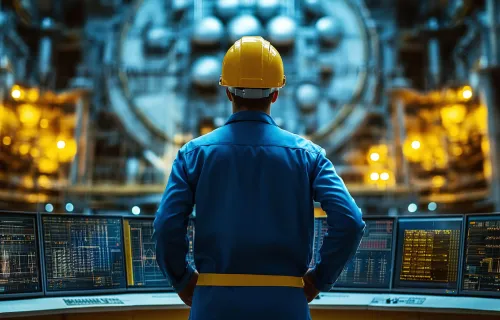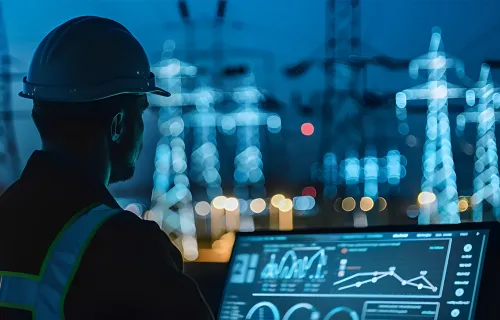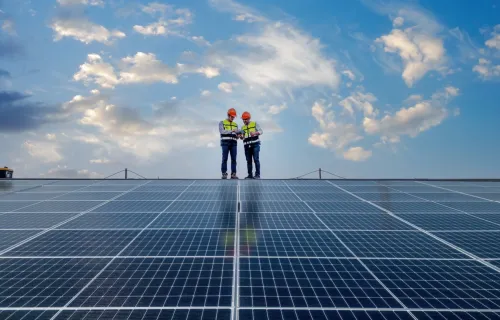In our latest Energy Transition Talks podcast, Peter Warren kicks off the first of two episodes with energy transition and Australian decarbonisation expert Pedro Carmo, exploring challenges, strategies and solutions for the journey to net-zero. Focusing on hard-to-abate industries, they discuss approaches to decarbonisation, success stories and the vital role real-time data plays in driving returns on investments.
Ambitious net-zero targets and sociopolitical context are driving momentum for the energy transition across all sectors. However, not all industries are readily adaptable to these targets, and a net-zero future will involve divergent paths and speeds. Hard-to-abate industries, like mining, fertilizers, steel, aluminium, industrial transportation and aviation, present complex decarbonisation challenges. But, as Pedro Carmo points out, net-zero will only be possible if we also decarbonise industries like mining, steel and fertilizers, which are heavy producers of CO2.
So how do hard-to-abate industries approach the journey? Where are examples in the market that successfully decarbonise the entire value chain? And how can data help maximize returns on decarbonisation investments?
A gradual, circular approach is key for decarbonising hard-to-abate industries
Electrifying our homes and cars with sustainable energy represents an important shift in ways of thinking and living, but the journey to net-zero for hard-to-abate industries is not as linear. Pedro points out that “a gradual, all-hands approach is most likely to succeed.” Companies need to start by setting net-zero targets and determining interim initiatives they can take. The key is balancing long-term and short-term actions.
So where should heavy industries start? Pedro recommends going back to basics by making sure whatever they produce is durable, to avoid frequent, wasteful redoing or replacing. He adds, “I think that’s the low-hanging fruit,” trying to make sure that the value chain is as efficient and circular as possible. Then, they can start shortening the supply chain and decarbonising it.
Companies should “bake-in” sustainability, like they do security
Market examples demonstrate that the journey to net-zero not only is possible for hard-to-abate sectors, but these efforts also drive innovation and operational efficiency.
In one instance, a European fertilizer company decarbonised its entire value chain. Pedro details their approach of building a solar power plant with battery storage, then using that renewable energy to produce green hydrogen and then ammonia, a key feedstock for the fertilizer industry. The result? “They are mostly auto-sufficient and not dependent on the main grid.” They still have a connection to the grid, but as a backup plan or to sell excess capacity if the prices are right.
Within mining, Peter also sees examples where a sustainability-first approach is driving innovation and improved efficiency, from using green hydrogen and a patented process for greener mining, to robotic digging using AI. He suggests that if you’re going to build something, make it more sustainable up front, as most organizations now know to do with security measures.
Near or real-time data is the foundation for better decisions, outcomes and returns
Data is key to decarbonisation. With the proliferation of new systems and solutions in energy and utilities, the amount of data collected continues to grow. More importantly, the availability of near or real-time data is increasing, enabling more actionable insights, not just for the operational efficiency of equipment, but also for business KPIs and returns on investment.
First, Pedro points out, we need to standardize the data. “In the example of the fertilizer industry, you have the solar panels, you have the electrolyzer, you have machinery to produce ammonia and so on.” All of these systems have different manufacturers and SCADA systems or ways of providing data, he notes. “It’s quite important to bring all that data together in a standardized way … across the entire process ...”
The integration and standardization of data across devices and OEMs is “a must-do” to enable real-time decisions. “Of course, companies want to maximize availability of their solar panels, their electrolyzers and so on. But, it goes beyond that.” Peter agrees that it is also about having a system that looks at the business KPIs. Are you getting your rate of return? Is it working the way you wanted? Is it generating the results you wanted from an investment or financial standpoint?
Using real-time data to examine availability is the first level of analysis, says Pedro: “Making sure things are working and producing. But then you get to maximizing performance, which is ‘Yes, my turbine or my solar panel are working, but then, are they working to the maximum of their capacity?’ And that’s called efficiency optimization. So that’s the next level up from KPIs.”
The next step is considering asset lifetime, according to Pedro. “Typically, these assets are very expensive and you want to maximize or extend their lifetime,” he states. You want to avoid having to frequently restart the assets, which leads to wearing them out and reducing their lifetime. “So, you need to balance all [these decisions] in order to maximize your return on investment.”
Stay tuned for more insights on these topics
Real-time data is crucial to the net-zero future. As more and more solutions emerge in the market to harness the potential of data-driven decarbonisation, there is still much more to discuss. We continue this exploration with Pedro and Peter in a second episode, coming soon.
Listen to other podcasts in this series to learn more about the energy transition.
Read the transcript:
- 1. Introduction
-
Peter Warren:
Hi everyone, and welcome to our next instalment on our energy insights series (Energy Transition Talks). Today, we're going to be talking a lot about net-zero, how the drive to a decarbonised economy is affecting all parts of the industry, energy and utilities wise. My guest is Pedro Carmo. Pedro, do you want to introduce yourself?
Pedro Carmo:
Sure, Peter. My name is Pedro. I've been working with CGI for many years, since 2000, give or take. All my career has been in energy and utilities. The last seven focused on renewables. At the moment, I'm Director, Consulting Expert for energy transition and decarbonisation.
Peter Warren:
That's great. And I should introduce myself as well. I'm Peter Warren. I'm the Global Lead for Energy and Utilities for CGI. I'm based just north of Toronto for this call. And Pedro's in Australia, although his accent is confusing, because you're Portuguese.
Pedro Carmo:
Yes. So I came back to Australia. I've been here before and I spent six years in Portugal. Then I decided to come back to Australia. It's a great country. It's in a great position for the energy transition, which we're going to talk about today.
- 2. Decarbonising hard-to-abate industries requires a gradual, all-hands approach
-
Peter Warren:
Yeah. We'll maybe talk about some of that as we get into it, about meeting some of your clients down there. So maybe I'll kick things off and just ask you an open-ended question. We can chime in on this. What do you see as the main drivers for the net-zero future? What do you see happening here?
Pedro Carmo:
Well, net-zero is, I'm not going to lie, it's going to be complicated, because we are putting a lot of aggressive targets. In this case, today in particular, we can talk about the other part, another day. But today we would like to focus a little bit on what we call the hard-to-abate sectors, in particular industries like mining, fertilizers, steel, aluminium, heavy transportation, aviation, et cetera. So, it's easier to electrify our houses, our cars, et cetera. But net-zero will only be possible if we also decarbonise industries like mining, fertilizers, which are heavy producers of CO2.
But yeah, as usual, I think a gradual all-hands approach is most likely to succeed. Like I said, it is not easy to decarbonise these industries straight away. I think every little thing will help. And we all need to do what we can to move towards a net-zero future. Yeah, it starts with you and me, Peter, but also goes all the way to these hard-to-abate sectors. And there are a lot of uncertainties and constraints. It's not going to be an easy path, but companies need to start by setting their net-zero targets. They need to think about the interim things they need to do. Then, of course, don't forget the small little things we can do every day and the short-term actions that they can perform as well.
Peter Warren:
Yeah. I agree with you. I don't think it's something where it's a big bang in every case. I know the mining industry, particularly in Australia, has been very, very good with doing innovation and lowering the different impacts it's had. Transportation as well, a huge one there. And this really then starts to put the challenges for these industries. What are they facing on their journey? Are there any points that you want to mention on that?
Pedro Carmo:
Yeah. So, it all starts with, and you can see it here in Australia, society and then the political context as well. Here is where you saw a big change in terms of political context. That basically is driving a lot of excitement at the moment. And that then brings the economics and the technology to the picture. Right? But if you have the right legislation and the right political environment, let's put it this way. It's quite important to start with. But, yeah. I'm sure that ... Go on, Peter.
- 3. Focusing on the basics of durability and efficiency helps drive decarbonisation
-
Peter Warren:
Yeah, no. No problem. I was just going to chime in there and say, so what do you think are the most promising options for decarbonisation? What might be the low-hanging fruit here for people to jump on quickly? Pedro Carmo:
That's a tough one, Peter. But I think we need to go back to the basics. We can talk about and we will talk about things like hydrogen, et cetera, but maybe start by making sure whatever you produce is durable. It's a good starting point. So, try to make good products or good things that last that, so we don't need to be redoing them all the time. I think that's the low-hanging fruit. Try to make sure that the existing supply chain, the existing value chain, et cetera, they are as efficient as possible. And then, you can start thinking about short-term actions and short-term options for decarbonising the industry.
Peter Warren:
Yeah. It's an interesting journey. And we used to say security (has to be) baked in to everything. And that, people even find that surprising, that security should be top to bottom. But I think ESG, environmental social governance and all the decarbonising is something that has to be baked in. So, if you're going to build something, include both security and making it more sustainable right up front and drive efficiencies. Do you have any examples, maybe from your own experience, that you could highlight?
Pedro Carmo:
Well, yeah. Indeed. So, for instance, an example I like to use is actually not my example. But there is one that I've been lucky enough to understand and to know the guys that did it. And it's an example in Spain where, basically, a fertilizer company, which is one of the hard-to-abate industries we talked about, basically decarbonised the entire supply value chain. They built a solar power plant with batteries, and then they used the solar energy and the batteries, of course, to store the energy where needed.
They used that energy produced by the solar panels to produce hydrogen through an electrolyzer. And then they use the hydrogen to produce ammonia, which is a key feedstock for the fertilizer they produce. So, basically, they are most almost auto-sufficient and detached in a way, or not dependent from the main grid. Although they do have a connection to the grid, of course, as a backup plan, but also to sell some excess capacity. But most of it is to just make sure that, if for some reason they don't have enough energy, they can always get some energy back from the grid. So, that's a clear example of how we could decarbonise one of the hard-to-abate industries.
Peter Warren:
Yeah. It's interesting too, and you mentioned mining as well. There's a gentleman here that I know. He has plans for building a mine and wants to make it green right from the beginning. He wants to have hydrogen involved, very much like what you talked about. They have a patented process for better mining and better services.
Then I even talked to a gentleman that we have in our employ, who I'm going to connect him with, that has a doctorate in a robotic digging, the ability to do both AI mining and digging with the systems. Something I didn't even know we knew anything about. But we have somebody that has a doctorate in that. It was a very fascinating conversation last Friday.
- 4. Standardizing and integrating data enables crucial real-time decision making
-
Peter Warren:
So, I mentioned AI and automatic digging. But what do you think from your standpoint is the technology that is going to be used here? What are the enablers? Where is the future for decarbonisation?
Pedro Carmo:
Well, I think in the end for me, everybody says this, I think it's true: data will be key and data's fundamental. Basically, all these systems rely on real-time data. And it's quite important. We are capable to acquire or ingest real-time data that comes from this, the solar panels, the electrolyzer, et cetera. So, we need to receive data, we need to monitor these devices in real time. We need to receive that data. We need to standardize the data, store it, and then, of course, make the analysis. But very important will be supporting the real-time decision-making process, using real-time data.
Peter Warren:
And I think that from the data standpoint too, there's the OEMs that actually do SCADA work. But it's really about going beyond maybe what you're getting from the OEMs and, or, applying other analytics. What's your viewpoint on that?
Pedro Carmo:
Correct. So, in the example of the fertilizer industry, you have the solar panels, you have the batteries, you have the electrolyzer, you have machinery to produce ammonia and so on. And all of these systems have different manufacturers. And each manufacturer will have different SCADA systems, if you want, or different ways of providing data. It's quite important to bring all that data together in a standardized way and basically use that, and have solutions that go across the entire process that are able to support decision making along the way. So, quite the integration, the standardization across devices, OEMs and so on. It's one of the key challenges on this industry, and basically a must-do thing in this case.
- 5. Using data for production optimization helps maximize ROI
-
Peter Warren:
Yeah. I know from your background in the past, normalizing wind turbines and other systems was something you did. But I think that looking at some of the ideas of solutions, it's going beyond the actual operation of the actual equipment, and really having a system that is looking at the business KPIs. Are you getting your rate of return? Is it working the way you wanted it to? Is it generating the results you wanted from an investment standpoint? Or an ongoing financial standpoint? In closing, do you have any final thoughts on that? And then we'll wrap this session up.
Pedro Carmo:
Absolutely. So, that's the next step. Well, as long as you have the data foundation, so you have your data coming in, in real time, so that can help, like I was saying before, the real-time decision making. But also, the other side of the equation, as I normally say, which is the analysis of the performance of your, let's call it landscape. And, basically, that's where all the KPIs will come in. Right? You will start looking at how good is my availability? So, of course companies want to maximize availability of their solar panels, their electrolyzers and so on. But then it goes beyond that.
So, availability's the first level. So, making sure the things are working are producing. But then you get things like maximizing performance, which is. "Okay. Yes, my turbine or my solar panel are working, but then, are they working to the maximum of their capacity or their expected, in this case for wind, power curve?" And that's called production optimization. So that's the next level up of KPIs.
And then you can even go above that, which is about taking in consideration the asset's lifetime. Typically, these assets are very, very expensive and you want to maximize or extend their lifetime. So, there’s no point to be all the time restarting the assets, because that will basically wear out those assets and reduce the lifetime. You need to balance all of that in order to maximize your return on investment.
- 6. Continuing the conversation in our next Energy Transition Talks episode
-
Peter Warren:
Well, that's great, Pedro. Thank you very much. We'll wrap this episode up. And I think what we'll do is we'll have a second episode and we'll explore some of those things a little further in the next one. So, thanks for teeing that up. So, thanks everyone. Please join us for our next one. Thank you, Pedro.
Pedro Carmo:
Thank you, Peter. Bye-bye. Peter Warren:
Bye-bye.




